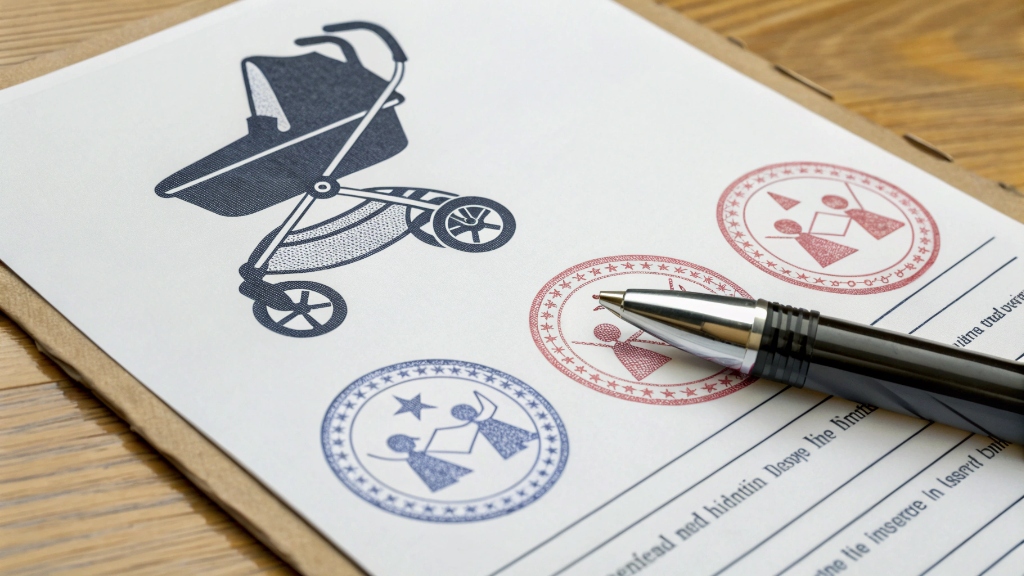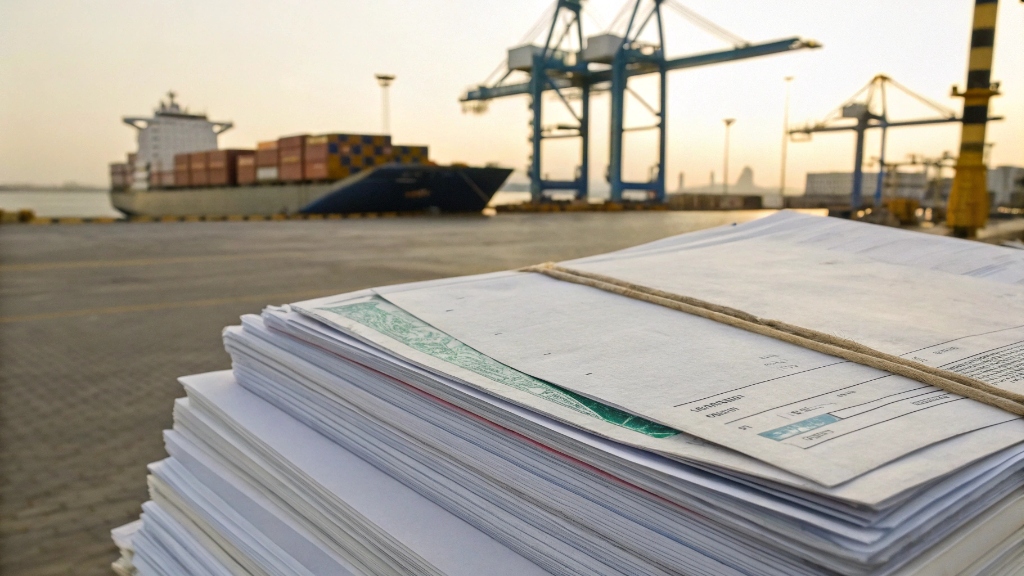Ever wondered how those sturdy high chairs get made? It is a complex process. You might worry about quality and safety. Understanding the steps helps you ensure safe products for children.
Children’s high chairs are manufactured through a multi-stage process. This includes careful material selection, precision component forming (like molding plastic and shaping metal), assembly, and rigorous safety testing. Factories prioritize design, durability, and compliance with strict international safety standards to create safe feeding solutions.
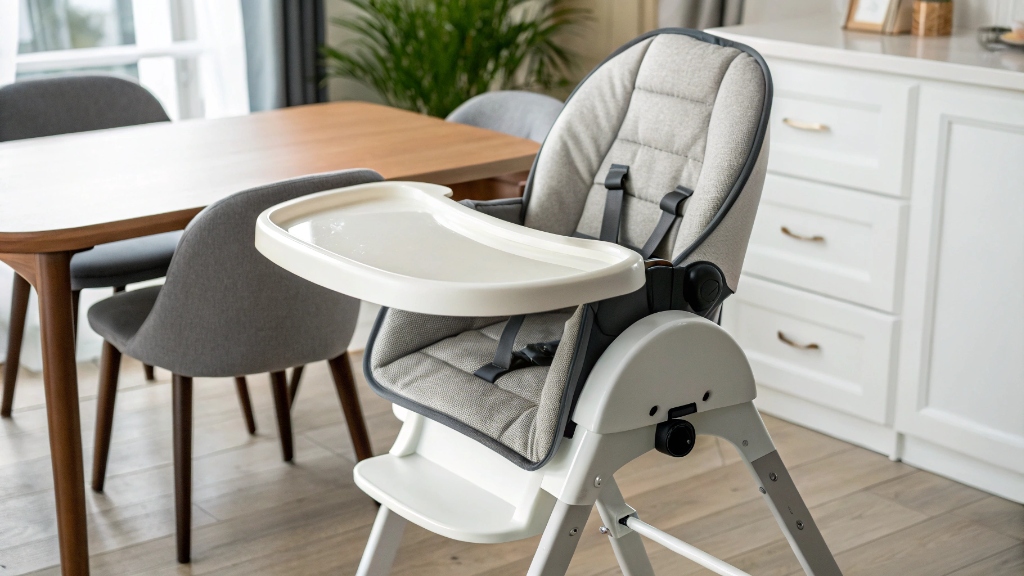
I remember the first time I visited a high chair factory. The sheer scale and precision involved in making these seemingly simple products amazed me. My company believes in building safe foundations for children before they go exploring the world. Knowing how these crucial items are made reinforces our commitment to quality. This experience taught me that detailed knowledge of the manufacturing process is essential for delivering the reliable products families need.
What materials are used to make children’s high chairs?
Have you ever thought about what materials make up a high chair? The choice of materials is crucial. It impacts durability and safety. Knowing this helps you choose quality.
Children’s high chairs are primarily made from durable plastics (like polypropylene), metals (steel or aluminum for frames), and sometimes wood. Fabrics for seating are often polyester or PU leather. These are chosen for comfort, cleanability, and non-toxicity. Material selection always prioritizes child safety and compliance with global standards.
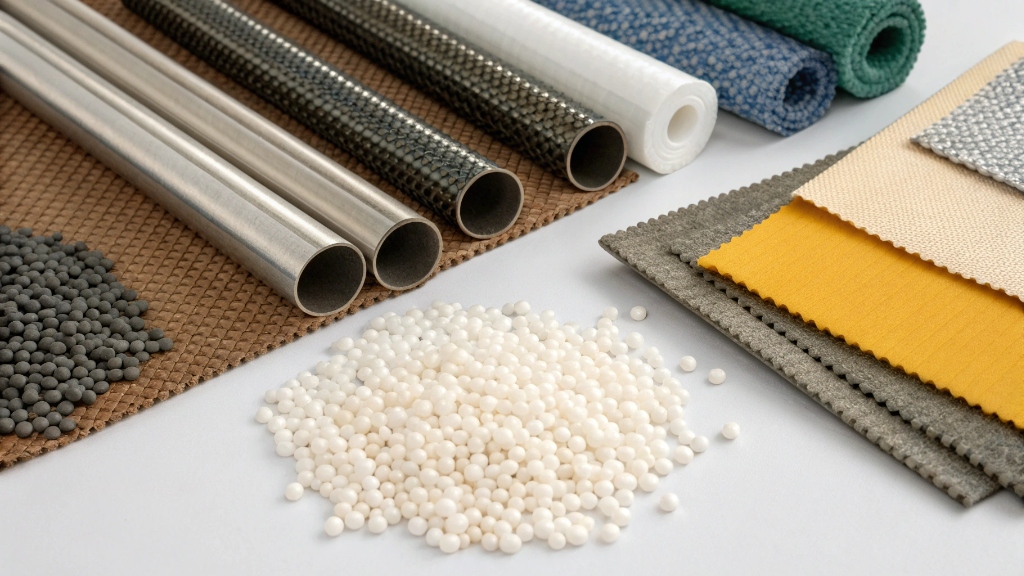
When we source high chairs, our material choices directly reflect our company’s values. We want products that are safe enough for infants. We also want them to be tough enough to last through years of active use. Children need to feel secure at mealtime. This allows them to develop independence before they are ready to explore the outdoors. My team spends a lot of time reviewing material specifications. We want to ensure they can withstand the wear and tear of daily family life. This includes everything from food spills to energetic wiggles. Our focus is always on creating products that promote both safety and active growth.
The Importance of Non-Toxic Plastics
Plastics are a very common material in high chair manufacturing. They are used for trays, seats, and other components. The most common type is polypropylene (PP). This plastic is known for its durability, resistance to heat, and ease of cleaning. It is also a food-grade plastic. This makes it safe for trays where food comes into contact. Other plastics like ABS might be used for parts needing extra strength or impact resistance. For our products, it is absolutely critical that all plastics used are BPA-free and phthalate-free. These chemicals can be harmful to children. We specifically look for certifications that confirm the absence of these substances. This ensures that even if a child mouths a part of the high chair, there is no risk of exposure to toxins. Our commitment to health and connecting with nature extends to the materials within the home. We believe in providing products that are pure and safe for growing bodies.
Durable Metals for Structural Integrity
The frame of a high chair provides its strength and stability. Metals like steel and aluminum are commonly used. Steel frames offer superior strength and durability. This ensures the high chair can withstand the weight and movement of an active child. It provides long-term stability. Aluminum frames are lighter. This makes the high chair easier to move and store. Both types of metal frames are usually treated with a powder coating. This coating protects against rust and scratches. It also adds to the aesthetic appeal. For our brand, the structural integrity of the high chair is paramount. We want high chairs that feel solid and dependable. They need to stand up to daily use. They need to be as robust as the outdoor gear we source. This ensures families have a reliable product for years.
Fabrics and Finishes for Comfort and Hygiene
Many high chairs come with upholstered seats or padded inserts. These add comfort for the child. The most common fabrics used are polyester and PU leather. Polyester is durable, stain-resistant, and easy to clean. PU leather offers a more premium look and feel. It is also very easy to wipe down. For young children, hygiene is very important. So, these fabrics are chosen for their practical benefits. We also ensure that any dyes or treatments used on these fabrics are non-toxic. We understand that spills and messes are part of childhood. Therefore, our focus is on materials that make cleanup simple. This helps parents maintain a hygienic environment for their child. It also extends the life of the product. This aligns with our mission of providing long-lasting, practical products for families.
| Material Type | Common Uses | Key Properties | Safety Considerations |
|---|---|---|---|
| Plastics | Trays, Seats, Footrests, Connectors | Durable, Easy to clean, Lightweight, Moldable | BPA-free, Phthalate-free, Food-grade (trays) |
| Metals | Frames, Legs, Supports | Strong, Stable, Durable (Steel); Lightweight (Aluminum) | Rust-resistant coating, Smooth edges |
| Fabrics | Seat pads, Harness covers | Comfortable, Easy to clean, Stain-resistant | Non-toxic dyes, Durable stitching |
| Wood | Frames, Seats (less common now) | Natural, Aesthetic, Sturdy | Non-toxic finishes, Splinter-free |
What is the manufacturing process for high chairs?
Ever wondered about the step-by-step journey of a high chair? From raw materials to a finished product, it is a detailed journey. Understanding each step shows the effort involved.
The manufacturing process for high chairs typically begins with component production, such as plastic injection molding for trays and seats, and metal forming for frames. These parts are then assembled, often semi-automatically, followed by upholstery, final assembly, and packaging. Quality checks happen at every stage to ensure safety and functionality.
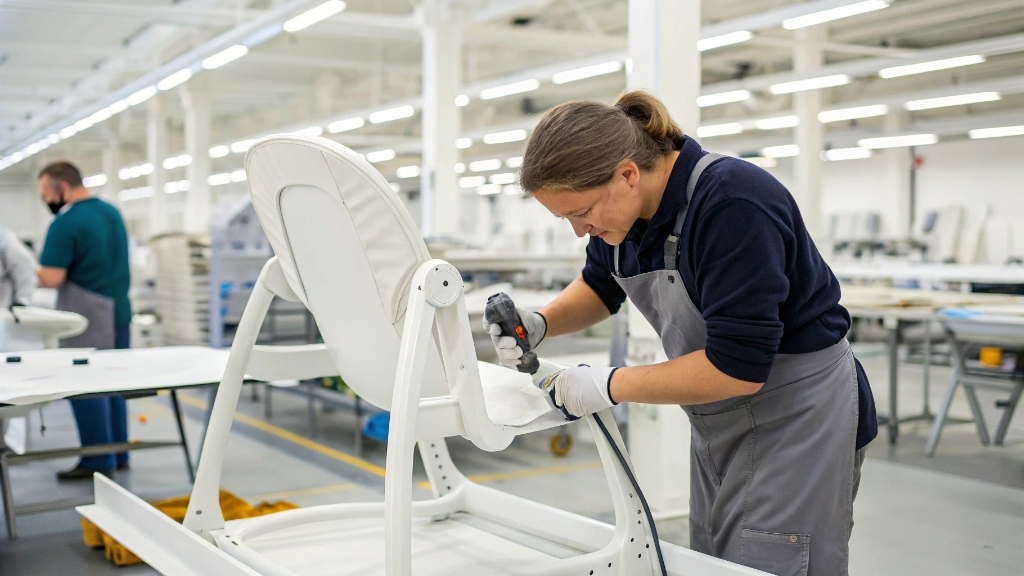
When I first started sourcing high chairs, I envisioned a simple process. I thought parts would just click together. But seeing it firsthand was eye-opening. There is a precise dance between machines and human hands. Every step needs careful attention. My company is committed to delivering products that support safe mealtimes. This means we value precision in manufacturing. Understanding the intricate steps helps me ensure our partners uphold the highest standards. It shows me where quality checks are most vital. This ensures every high chair is as robust and reliable as the adventure gear we provide for older children.
Component Creation: Molding, Cutting, and Shaping
The manufacturing process begins by creating the individual parts of the high chair. Plastic components, like the large feeding tray or the seat shell, are made using injection molding. Here, plastic pellets are melted and injected into molds under high pressure. This forms the precise shapes needed. For metal frames, long tubes of steel or aluminum are first cut to specific lengths. Then, specialized machines bend these tubes into the required frame shapes. Welding might also be used to join metal pieces together permanently. Other parts like screws, bolts, and harnesses are either manufactured in-house or sourced from specialized component suppliers. This initial stage requires careful calibration and precision. It ensures all parts fit together perfectly later. My company believes in products that are built to last. This commitment starts right here, with the foundational quality of each individual component.
Assembly Line Efficiency
Once all components are ready, they move to the assembly line. High chair assembly often involves a mix of automated and manual processes. Robotic arms might handle repetitive tasks like bolting larger frame sections together. Human workers then complete more intricate steps. These steps include attaching plastic seats, footrests, and wheels. They also install the complex safety harness systems. Efficient assembly lines are designed to minimize waste and maximize output. Each worker often specializes in a specific task. This ensures consistency and speed. Quality checks are integrated throughout the assembly process. Workers visually inspect parts as they are assembled. This helps catch any defects early. Our focus is on ensuring every high chair is put together with care. This means it will provide a stable and safe platform for a child. This careful assembly process builds a product that will support our values of active, healthy children.
Upholstery and Finishing Touches
After the main structure is assembled, the high chair often moves to the upholstery and finishing stations. Here, fabric covers and padded inserts are cut, sewn, and fitted onto the seat and backrest. This requires skilled textile workers to ensure a neat and comfortable finish. At this stage, the safety harness system is fully integrated. This includes attaching the straps, buckles, and adjusters. All edges are smoothed. All surfaces are cleaned. Any protective caps or stoppers are added. The final brand labels and warning labels are affixed permanently to the product. These finishing touches are vital for both the appearance and the safety of the high chair. They ensure every high chair is ready for packaging. It ensures it meets our high standards for a product that is both functional and aesthetically pleasing.
Packaging for Safe Transit
The final stage is packaging. High chairs are often designed to be easily disassembled or folded for compact packaging. This helps reduce shipping costs and prevents damage. Each high chair is carefully placed into a strong, corrugated cardboard box. Inner packaging materials like foam, cardboard inserts, or plastic bags protect individual components from scratching or shifting during transit. The user manual and any assembly tools are included. The outer carton is labeled with product information, safety warnings, and shipping details. We pay close attention to packaging quality. We want our high chairs to arrive in perfect condition. This reflects our commitment to delivering a perfect experience to our customers.
| Manufacturing Stage | Key Activities | Quality Control Points | Tools/Machines Used |
|---|---|---|---|
| Component Creation | Molding plastics, cutting/bending metals, welding | Material inspection, dimensional checks, visual inspection | Injection molding machines, CNC cutters, Welding robots |
| Assembly | Bolting frames, attaching seats, installing harnesses | Fit & finish checks, functional tests (folding) | Manual assembly, pneumatic tools, automated assembly jigs |
| Upholstery/Finishing | Cutting/sewing fabric, attaching labels, cleaning | Stitching quality, label accuracy, surface finish | Sewing machines, heat presses, cleaning stations |
| Packaging | Folding/disassembling, packing in cartons, labeling | Quantity check, packaging integrity, labeling accuracy | Carton sealers, weighing scales, labeling machines |
How are high chairs tested for safety and quality?
Do you trust the safety of a high chair? Rigorous testing is essential. It ensures the chair protects a child. Knowing how they are tested builds confidence.
High chairs undergo extensive safety and quality testing to meet standards like ASTM F404 and EN 14988. Tests include stability checks, structural integrity analysis, restraint system strength evaluations, and material composition analysis. These rigorous checks ensure the high chair is safe, durable, and reliable for children before it leaves the factory.
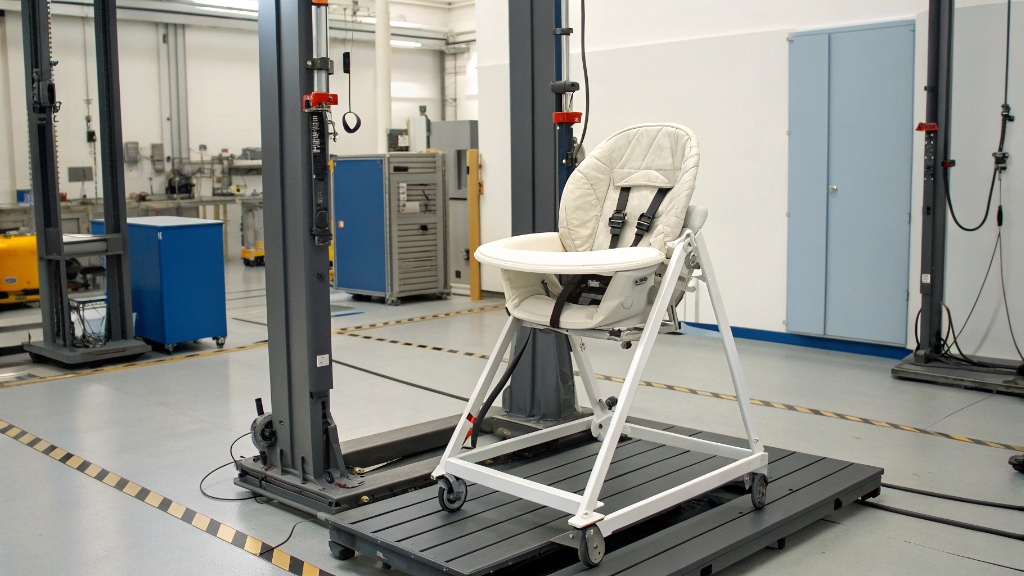
For my company, safety testing is not just a checkbox; it is a fundamental part of our promise to parents. I often imagine a child in one of our high chairs. I picture them wiggling, reaching, and sometimes being quite energetic. This internal vision drives our demand for thorough testing. Our products are meant to support active childhoods. This includes ensuring they are safe during meal times at home. My team reviews every test report with extreme scrutiny. We know that these reports represent the peace of mind we offer to families. This dedication to testing ensures our high chairs are as robust as the outdoor gear we expect our customers to use for their adventures.
Stability and Structural Integrity Tests
One of the most critical aspects of high chair safety is its stability. High chairs must be able to withstand a child’s movements without tipping over. Testing labs conduct several types of stability tests:
- Tipping Tests: Weights are placed on various points of the high chair, such as the edge of the tray or the footrest. This simulates a child pushing off or leaning. The high chair must remain upright.
- Dynamic Load Tests: This test simulates a child wiggling or pushing against the seat and tray. It involves repetitive forces applied to different parts of the chair.
- Static Load Tests: Heavy weights are placed on the seat, footrest, and tray for extended periods. This checks for deformation or structural failure.
The structural integrity of the frame is also tested. This includes impact tests. Components are hit with specific forces. It also includes fatigue tests. Parts are subjected to repeated stress cycles. These tests ensure that no parts break, bend, or detach. This prevents potential injuries. My company sources products that are built for active kids. This commitment to durability starts with ensuring the basic structure can handle any child’s energy.
Restraint System and Locking Mechanism Checks
A high chair’s restraint system (harness) is vital for keeping a child safely in place. These systems undergo stringent testing:
- Harness Strength Tests: The straps and buckles are pulled with significant force. This ensures they do not break or detach.
- Buckle Durability Tests: The buckles are opened and closed thousands of times. This simulates repeated use. It ensures they remain functional and secure.
- Tray Locking Mechanism Tests: The tray’s locking mechanism is tested for strength and ease of release. It must lock securely but also be easy for an adult to open. It must not be easy for a child to open.
These tests prevent accidental falls or releases. They ensure the child remains safely seated throughout mealtime. For our products, we pay close attention to these details. We know parents rely on these safety features every single day. This careful attention ensures our high chairs are truly safe.
Material Safety and Non-Toxicity
Beyond physical strength, the materials themselves must be safe for children. Testing includes:
- Chemical Analysis: Materials are tested for the presence of harmful substances like lead, phthalates, and other heavy metals. This ensures compliance with regulations like CPSIA (US) and REACH (EU).
- Small Parts Test: Any small components that could potentially detach are tested. They are checked to ensure they cannot become a choking hazard for young children.
- Sharp Edges and Points: The entire high chair is inspected. It is checked for any sharp edges, points, or pinch points that could injure a child.
- Flammability Testing: Fabrics and foam inserts might be tested for flammability. This ensures they meet fire safety standards.
These material safety checks ensure that the high chair is not only physically safe but also chemically harmless to a child. My company is deeply committed to the health and well-being of children. This is why we insist on the highest standards for material non-toxicity.
Durability and Lifecycle Testing
High chairs are used frequently, often multiple times a day. Durability testing simulates long-term use:
- Folding/Unfolding Cycle Tests: If the high chair is foldable, its mechanism is tested through thousands of cycles. This ensures it remains functional and safe over time.
- Wear and Tear Simulation: Surfaces are tested for scratch resistance. Fabrics are tested for abrasion resistance. This simulates everyday use.
This ensures the high chair maintains its safety and functionality throughout its expected lifespan. This type of rigorous testing aligns perfectly with our company’s philosophy. We believe in providing products that are not just safe, but also incredibly durable. We want our high chairs to endure the adventures of childhood, just like our outdoor gear.
| Safety Test Category | Specific Tests Performed | Purpose of Test | Relevant Standards (Examples) |
|---|---|---|---|
| Stability | Tipping tests (forward, backward, sideways), Dynamic load tests | Prevents high chair from falling over | ASTM F404, EN 14988 |
| Structural Integrity | Static load tests, Impact tests, Fatigue tests | Ensures frame and components do not break/deform | ASTM F404, EN 14988 |
| Restraint System | Harness strength, Buckle durability | Keeps child securely seated, prevents falls | ASTM F404, EN 14988 |
| Tray/Locking | Tray strength, Locking mechanism security/durability | Prevents tray detachment, ensures child cannot release | ASTM F404, EN 14988 |
| Material Safety | Chemical analysis (lead, phthalates), Small parts test, Sharp edges | Ensures non-toxic materials, prevents choking/cuts | CPSIA, REACH, EN 71 (toys) |
| Durability | Folding cycle tests, Abrasion tests | Ensures long-term functionality and safety | ASTM F404, EN 14988 |
Conclusion
Manufacturing children’s high chairs involves careful material selection, precise component creation and assembly, and rigorous safety testing. This ensures durable and reliable products, supporting safe mealtimes for children everywhere. Therefore, choosing us Anhui Windmill Imp. & Exp. Co., Ltd. directly is your best decision. We are wholeheartedly committed to providing the best products and excellent service.


